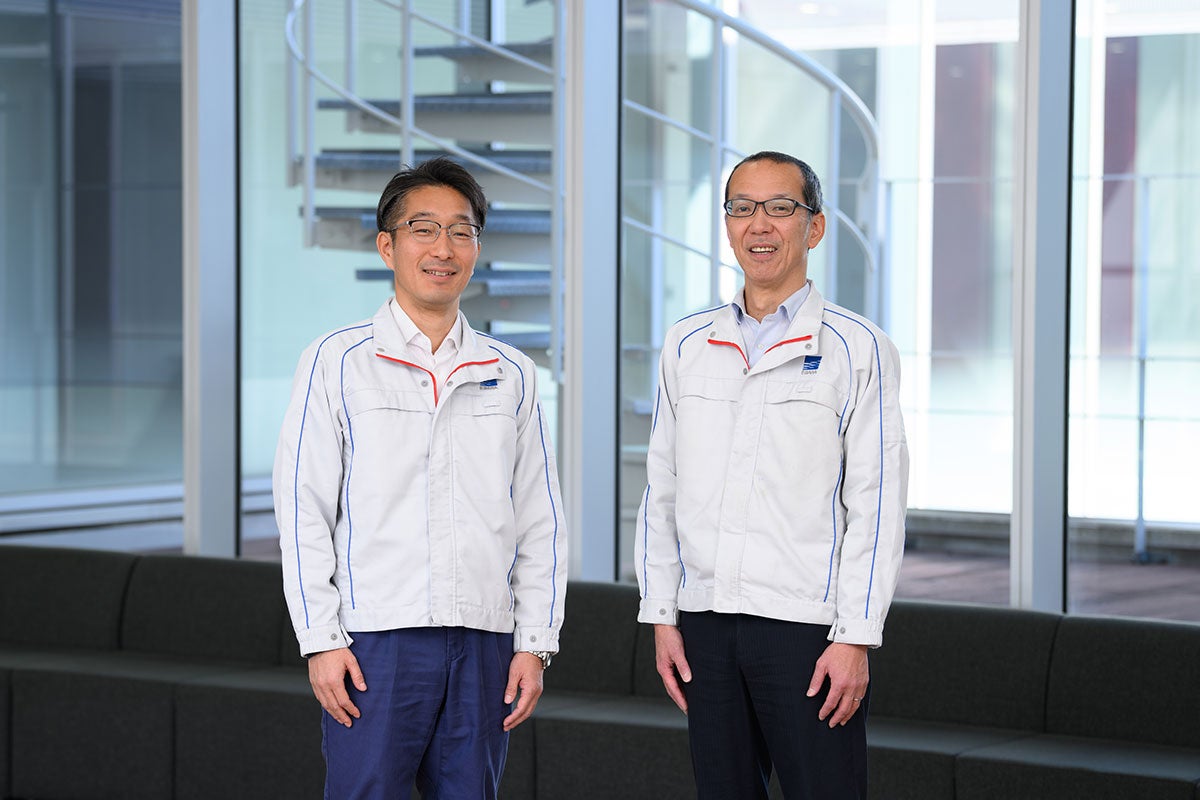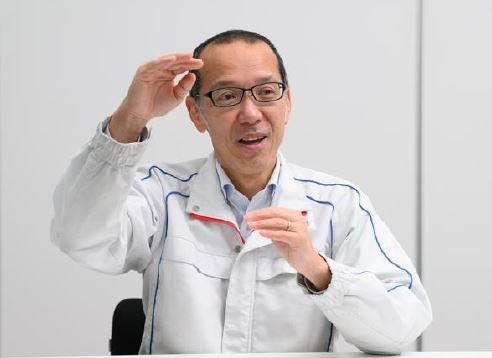The Ebara Manufacturing Technology Advanced Center (EMTAC) is a base that supports manufacturing for the entire Ebara Group. EMTAC provides prototypes required for product development, treating each location and department in the Group as a valued customer. Their catchphrase is "Get your development prototype in three days!" The impetus for starting these activities came when EMTAC was asked to "make a prototype of a certain pump product in a short period of time" while listening to the customer's issues.
Takashi Yamakawa of the Manufacturing Technology Development Department, Production Process Innovation and Quality Assurance Division, who leads EMTAC, and Hiroyuki Kawasaki of the Industrial Business Development Department, Development Division, Construction & Industry Company, who initiated the prototype project, talked about the background and the value of EMTAC.
The Goal: Development Prototypes Ready in 3 Days What EMTAC Brings to Ebara’s Technologies

Already receiving 100 requests per year, this initiative began with a "single voice" from a certain department.
How did the new initiative "provision of prototypes" begin?
—What kind of organization is EMTAC?
Yamakawa: This is a base that does not belong to a specific business division and supports manufacturing for the entire Ebara Group. There are two main activities. The first is to listen to the concerns and issues each business division has about manufacturing and work together to help resolve them. Currently, we are working with 17 bases and departments in Japan and overseas to solve problems.
Another activity is that we quickly create and provide prototypes required for product development in each business division.

Innovative Production Engineering and Quality Assurance Division, Manufacturing Technology Development Department
—Why did you set up EMTAC and begin these sorts of activities in the first place?
Yamakawa: Even before starting EMTAC, I was involved in manufacturing across the entire company as a corporate organization. We were looking for ways to contribute more to the business functions and to the company as a whole. That’s why we had the idea of creating an organization that would treat in-house departments and bases as actual customers, listen to concerns and solve problems together within the company. That led to EMTAC being born in 2020, to provide support for solving “monozukuri” problems in different business segments. When we first started, we supported the business division in solving manufacturing problems.
—So why did you start delivering prototypes?
Yamakawa: As I was visiting each business division and listening to their concerns and problems, I received a request from Kawasaki's department to make a prototype.

Building Service & Industrial Company
Development Division
Industrial Business Development Department
Kawasaki: That's right. Our department develops industrial pumps that are used in plants and other such facilities. We had just received a request from a certain customer to create a prototype for a new product in a short amount of time when I was told that EMTAC wanted to discuss our development issues and requests, so we consulted with them about creating a prototype. We had just received a request from a certain customer to create a prototype for a new product in a short amount of time when I was told that EMTAC wanted to discuss our development issues and requests, so we consulted with them about creating a prototype. We usually outsource manufacturing, but this was our first collaboration with EMTAC.
We had several goals in asking EMTAC for help. First, we wanted to speed up the process by creating prototypes in-house. In-house production allows us to quickly go through the full PDCA cycle, from prototype production to evaluation of the finished product, and then adjustment. It is also expected that overall delivery times will be shortened. Since we are not an external company, we do not require an NDA (non-disclosure agreement).
Prototypes of new products that have not yet been produced in the world may have a never-before-seen shape or a unique shape. The experience of manufacturing such prototypes is valuable, and we thought that accumulating the manufacturing knowledge gained from it within the company would lead to raising the level of manufacturing throughout Ebara.
EMTAC was recognized for drastically reducing delivery times to under a month and won the Grand Award of the Ebara Global Challenge Award (EGCA), a company-wide program that recognizes those undertaking challenging initiatives at Ebara.
—How did you feel when you received a request from Mr. Kawasaki to make a prototype?
Yamakawa: I didn't think it would be an easy job. However, as Mr. Kawasaki said, being able to create prototypes within Ebara would be of great value, and we have long felt that such an internal organization was necessary. While there is no doubt that the role would be difficult, declining to take on that role and declaring that it couldn’t be done would only mean putting the brakes on progress taking place at the company and at EMTAC. Even if it was difficult at first, I thought I would give it a try through trial and error.
Of course, various knowledge and skills are required for production, but EMTAC has members with experience in manufacturing in various businesses and departments. We thought that EMTAC's strengths, which have a wide range of technologies, would be utilized.
—When the prototype was actually delivered, how did things look and what kind of speed was involved?
Kawasaki: We initially requested a small amount, but it was completed in about a month. It was faster than outsourcing externally and the quality was good too. After that, we started asking for prototypes many times and the quantity increased, but each time the production speed increased and the delivery time became shorter.
Yamakawa: Every time we received a request, we would think about "which process can we shorten next time?" Delivery times, which were a month at first, became two weeks, then ten days...and so on. Gradually, requests began to come in from other departments, so we decided to fully roll out this initiative to the entire company.
Since we were going to roll it out to the entire company, we thought we should come up with an easy-to-understand catchphrase, and that's how we came up with "Development prototype in your hands in 3 days!" That's it. Currently, in addition to pumps, we receive more than 100 prototype requests per year for semiconductor-related and new business ventures.
—This activity also resulted in the winning of the EGCA Grand Award. Looking at everything again, how do you both feel about the value and benefits provided by doing things in-house when it comes to the production of prototypes?
Kawasaki: I think it's great that EMTAC makes prototypes, which allows designers like us to hear opinions from the manufacturing side from a very early stage of product development. Product designs are based on what we, the designers, have in our minds or based on data. However, when commercializing a product, whether or not it is easy to manufacture onsite or at all are important factors to consider and the best way to find out is to listen to the voices of those who manufacture the product. The best way to find out is to listen to the voices of the people who make them.
Based on that premise, EMTAC is an organization within the same company, so they will honestly and unobtrusively tell you their opinions on the manufacturing process. For example, if EMTAC gives us feedback at the prototype stage saying, "It's difficult to make this in reality," we can revise the design at an early stage.
Yamakawa: By prototyping the latest products, I think EMTAC has the potential to become a hub connecting different technologies within the group. It may be possible, for instance, for the technologies utilized in pump prototypes to be deployed to other departments via EMTAC. I believe this will contribute to raising the level of manufacturing across Ebara, and will enable us to bring better products to market more quickly.
Like EMTAC, we started by drawing a small circle and then experienced
—What are the prospects for EMTAC in the future?
Yamakawa: We've been receiving a lot of prototype requests from various departments, and we're screaming with joy. We will continue to make efforts to deliver prototypes as quickly as possible.
We will strengthen our efforts in safety and health, the basics of manufacturing, 5S, energy conservation and CO2 reduction, and continue our activities to contribute to carbon neutrality.
—Finally, as two of you who have been involved in manufacturing for many years, please give a message to young people working at Ebara and those who are interested in manufacturing.
Kawasaki: What I want to tell young people is that no matter how small the job, I want them to gain experience in seeing it through to the finish line. One lap around that circle from start to the finish actually signifies the start of another endeavor. In other words, when you go around the circle from the start to the goal, it's like you're actually starting the next circle.
The important thing is to complete one circle from the start to the goal, even if it's a small circle. If you have a great start but end up stopping in the middle, you don't have the full experience of that task to completion. Even if the circle is small, going around it once and getting back to the starting line means that you can draw a bigger circle to go around next time. I think it's a repetition of that.
Yamakawa: I feel the same way, but I want young people to take on new challenges and not give up easily. Even if something is difficult, there is nothing to be gained if you just give up then and there, declaring the endeavor to be impossible. I think it's important to try things, not give up easily, consult with others, and think about what elements are necessary to make it possible.
Kawasaki: Even when we were working on the prototype, Mr. Yamakawa didn't say "it can't be done," but he worked on it and it grew. In manufacturing, the most important thing is not to give up easily and to see things through, even if they are small.












